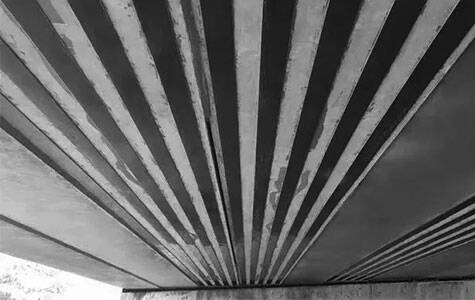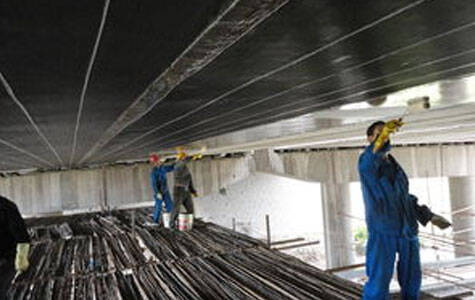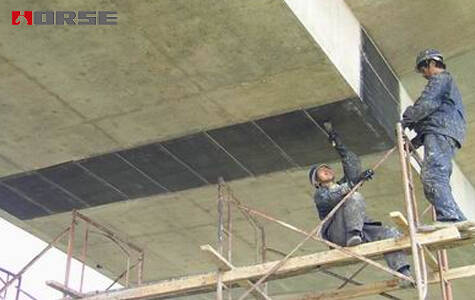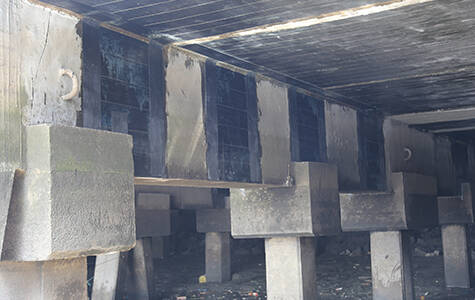Solutions
Horse Construction offers full range of structural strengthening materials with technical supports, documentation supports, products supports, project supports.
Reinforcement Of Bridge Beams Using Carbon Fiber Sheet In One Direction


Cases of strengthening a bridge with carbon fiber sheet in one direction
1. The Jiuba River Bridge is located at K2464+284 on the G312 line. The bridge was built in 1992. It is a 5-hole 10m simply supported hollow slab bridge with a design width of the bridge deck, a net 11+2x0.5m safety belt, design load: steam one 2O, hanging one 100, design flood frequency: 1/50, bridge length 50.8m, The bridge pier is a gravity pier, and the foundation is an open-cut and enlarged foundation. In order to improve the overall stress of the bridge and prevent further cracks, a reinforcement plan of pasting carbon fiber sheet was adopted. Set a length of 10m and a width of 30cm of carbon fiber sheet 6 lanes along the clear distance of 70cm in the middle of the span. Three 30cm wide carbon fiber sheets are arranged along the longitudinal bridge direction, and the specific positions are the two ends and the middle of the horizontal carbon fiber sheet. The reinforcement time is July 2007.
2. Wuli Shagou Bridge is located at K2495+343 of G312 Line. The existing bridge is 31m long, with a clear bridge deck width of 11m and a safety bandwidth of 0.5mx2. The design load of the original bridge is 2O for steam and 100 for hanging. During the construction of the bridge, the hollow slab was cast integrally at one time, and the section size and reinforcement were not changed corresponding to the cast-in-place integral slab, resulting in the conversion of the unidirectional force on the superstructure to the bidirectional force slab. With the increase of service life, due to the effect of transverse bending moment and concrete shrinkage, many longitudinal cracks appear in the weakest hollow of the lower edge of the original bridge deck. And the cracks are concentrated in the horizontal main carriageway, within 4m on each side of the center line of the bridge deck. The cracks are wide in the range of longitudinal mid-span to 1/4L. Part of the hollow slab is severely carbonized, and the original hollow slab is rough in appearance, and the bottom of the board is uneven. Reinforcement plan is to take to enhance the lateral bending resistance of the overall plate. The longitudinal seam is sealed by pressure injection method, and the carbon fiber sheet in one direction is pasted on the bottom of the board to increase the lateral bending resistance of the overall board. The surface cracked part is coated with epoxy resin, and the bridge deck steel reinforced concrete paving layer is added to improve the overall performance of the bridge deck. The reinforcement time is September 2008.
3. Niuwanggong Bridge is located at K2500+663 of G312 Line. The current bridge is 8.7m long, with a clear bridge deck width of 11m and a safety bandwidth of 0.5mx2. The design load of the original bridge is: 20 for steam and 100 for hanging. The construction condition and damage degree of the bridge are the same as the Wuli Shagou Bridge. The reinforcement and transformation plan is to take to enhance the lateral bending resistance of the overall plate. The longitudinal joints are sealed by pressure injection method, and carbon fiber sheet in one direction is pasted across the bottom of the board to increase the horizontal bending resistance of the overall board. The surface cracked part is coated with epoxy resin to eliminate the carbonized corrosion layer of the abutment cap concrete. Mortar repair. Reinforcement time is June 2009.
The above three bridges are reinforced by pasting carbon fiber sheet. By pasting unidirectional carbon fiber sheet for reinforcement and transformation, the structural force performance can be improved or improved, and it can be put into use again.


The advantages of one direction carbon fiber sheet to strengthen the bridge
1 The unit weight of carbon fiber sheet is much lower than that of steel, and the construction is relatively simple. The on-site pasting does not require heavy equipment, the construction is convenient, and it is convenient for high-altitude operations under the bridge. It can be popularized and applied on highway bridges.
2 The chemical structure of carbon fiber is stable, and it will not be corroded by acid, alkali, salt and various chemical media. It has good cold and heat resistance.
3 Pasting carbon fiber sheets to reinforce concrete bridges is a new technology, which makes the pasting reinforcement method a fast strengthening method for highway bridges. It is suitable for the requirement that the normal operation of the bridge is not affected as much as possible during the strengthening of the highway bridge.
4 Carbon fiber sheet in one direction is a better reinforcement method for highways and old concrete bridges, and it has a better application effect in engineering. It can also assist other schemes. The reinforcement methods of pasting carbon fiber sheets are often supplemented by crack grouting, crack sealing and other methods.
You can find anything here you are in need of, have a trust trying on these products, you will find the big difference after that.

High strength carbon fiber reinforced polymer (CFRP) strip / laminate / plate for structural strengthening and concrete repair

High strength, unidirectional carbon fiber fabric pre-saturated to form a carbon fiber reinforced polymer (CFRP) fabric used to strengthen structural concrete elements.

High strength, unidirectional carbon fiber sheet pre-saturated to form a carbon fiber reinforced polymer (CFRP) sheet used to strengthen structural concrete elements.